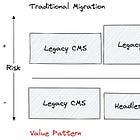From Legacy Chaos to Digital Excellence—A 30% Conversion Rate Breakthrough
Transforming an enterprise content management legacy into a modern revenue engine through strategic platform migration
Context
Picture this: a leading enterprise with millions of monthly visitors trapped by their own digital success. Their legacy content management system—once cutting-edge—had become their biggest bottleneck. This wasn't just any company; we're talking about a major player with substantial online presence, where every percentage point in conversion directly translates to millions in revenue.
The digital landscape had shifted dramatically around them. What worked in 2005 was choking their growth in 2013. Mobile-first experiences, personalization at scale, and real-time content optimization weren't nice-to-haves anymore—they were table stakes for survival in an increasingly competitive market.
This migration wasn't just about escaping legacy debt; it was about building a platform for sustained digital leadership. Sometimes the best technology decisions are the ones that make future decisions easier.
Problem
The client's legacy CMS was like trying to run a Formula 1 race with a horse and buggy—technically possible, but not set for success.
The facts:
Content velocity was glacial: Publishing new content required multiple departments, lengthy approval chains, and often took weeks for simple updates
Mobile experience: Built in the desktop-first era, mobile users were getting a cramped, slow, frustrating experience
SEO: Technical debt had accumulated to the point where basic SEO optimizations were nearly impossible to implement
Analytics blind spots: Data was scattered across multiple systems with no unified view of user behavior
Developer productivity was tanking: Simple changes required architectural gymnastics
The biggest problem: conversion rates were flatlining while competitors were pulling ahead. Every day they delayed was money left on the table and market share lost forever.
Any migration had to happen without disrupting their ongoing business operations.
Solution
Successful platform migrations sometimes aren't really about technology—they're about change management wrapped in code. The technical challenge was significant, but the human and business challenges were exponentially harder.
Rather than the typical "rip and replace" approach, we designed what I call a "Value Pattern" migration—systematically replacing legacy components while maintaining full operational continuity by prioritizing components by value.
Learn more about the value pattern here:
The technical foundation:
Headless CMS architecture: Decoupled content management from presentation, giving us flexibility to optimize each layer independently
API-first design: Every piece of content became accessible via clean APIs, future-proofing for omnichannel experiences
Progressive web app approach: Built for mobile-first but desktop-optimized, ensuring lightning-fast performance across devices
Services for critical paths: Isolated high-traffic functionality to prevent cascading failures
The secret sauce wasn't the technology stack—it was the cross-functional team structure I assembled. Instead of the traditional IT-driven approach, I embedded business stakeholders directly into the development process.
Team composition:
Engineers who understood business impact, not just code quality
Designers who thought in conversion funnels, not just UI interfaces
Product Managers who could translate revenue requirements into technical specifications
SRE engineers focused on zero-downtime deployments
We implemented two-week sprints with business validation gates—no feature started or shipped without demonstrable business value. This wasn't just agile methodology; it was agile with value-driven accountability.
The migration followed a "dark launch" approach: new components were built and tested in production alongside legacy systems, with traffic gradually shifted based on value-driven metrics. If anything went wrong, we could instantly rollback without user impact.
Key technical decisions:
Feature flags for gradual rollout: Controlled exposure of new functionality to user segments
Real-time monitoring and alerting: Custom dashboards tracking both technical performance and business metrics
Automated testing across user journeys: End-to-end tests covering critical conversion paths
Go-to-market
Platform launches fail not because of bad technology, but because of bad adoption strategies. I've seen too many valuable technical solutions gather dust because nobody planned for human behaviour.
Internal rollout phases:
Power user validation (Week 1-2): Content managers tested core workflows with direct feedback loops
Org training (Week 3-6): Customized training based on each team's specific use cases
Full organizational enablement (Week 7-8): Company-wide launch with dedicated support channels
The customer-facing rollout was invisible by design. Users experienced gradually improving performance and functionality without disruption. We monitored user behavior patterns to ensure the new experience felt familiar while delivering superior performance.
Rollout metrics we tracked:
Page load times (technical health)
Content publication velocity (operational efficiency)
User engagement patterns (experience quality)
Conversion funnel performance (business impact)
I also implemented "champions" within each department—identifying enthusiastic early adopters who became internal advocates and trainers. This peer-to-peer knowledge transfer proved more effective than top-down training mandates.
Outcome
The numbers tell a compelling story, but the strategic impact runs much deeper.
30% increase in conversion rates: The headline number that paid for the entire project multiple times over
60% reduction in content publication time: From days to hours for standard updates
40% improvement in mobile page speeds: Critical for user experience and SEO rankings
25% increase in organic search traffic: SEO optimizations finally became feasible
55% reduction in development cycle time: New features could be deployed rapidly
But here's what the metrics don't capture explicitly: the organization became digitally agile for the first time. They could now respond to market changes in days rather than months.
The platform enabled capabilities that were previously impossible:
Real-time content personalization based on user behavior
A/B testing at scale for continuous conversion optimization
Omnichannel content distribution preparing them for future channels
Data-driven decision making with unified analytics across all touchpoints
This project crystallized three principles I now apply to every major transformation:
Technology follows strategy, never leads it: The best technical solution is worthless if it doesn't solve actual business problems
Migration success is measured in adoption, not deployment: Going live is just the beginning; true success happens when people change their behavior
Cross-functional teams beat functional silos every time: The magic happens at the intersections between disciplines
Eighteen months post-launch, the platform continued delivering compounding returns. The client's ability to rapidly test and iterate new features became a competitive advantage, enabling them to capture market opportunities that their slower-moving competitors missed.
The modern architecture also positioned them for future growth—when they needed to integrate with new marketing tools, expand internationally, or adapt to new digital channels, the foundation was already there.




